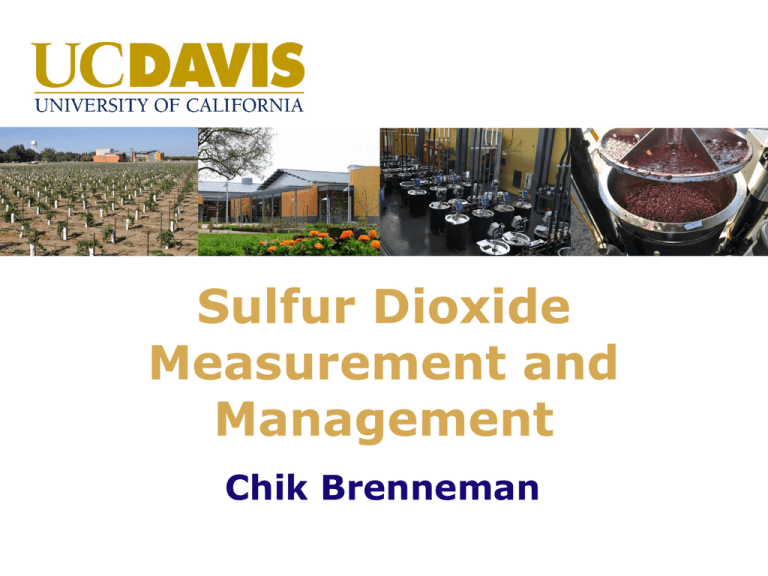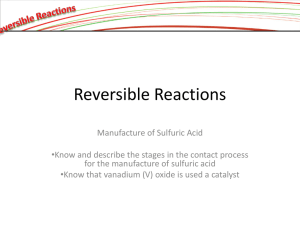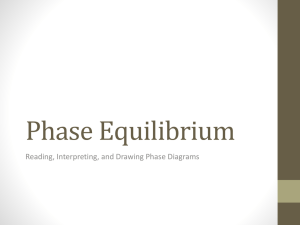Sulfur Dioxide Measurement and Management
advertisement

Sulfur Dioxide Measurement and Management Chik Brenneman Anita Oberholster Sulfur Dioxide Measurement and Management Introduction • What is sulfur dioxide? • Why is it important • Practical considerations for winemaking/Management during aging • Measurement techniques • What does it mean? • Alternatives Sulfur Dioxide Measurement and Management Overview • Chemical antioxidant and inhibitor of microbial activity • Labeling requirements • Industry wide trend for reduction in use Sulfur Dioxide Measurement and Management Chemical antioxidant • Inhibitor of browning reactions in juice • Polyphenol oxidase • Cultivar, juice vs. must • Typical additions of 30-50 mg/L • Laccase is minimally affected • Residual laccase activity in wine can cause browning • Participates in binding reactions • Aldehydes, e.g. acetaldehyde • Anthocyanins Sulfur Dioxide Measurement and Management Inhibitor of microbial activity • Juice – levels for enzyme inhibition are sufficient for inhibition or significant reduction in native flora • In General • Bacteria are sensitive • Yeast are less sensitive • Sensitivity varies by organism Sulfur Dioxide Measurement and Management Sulfur Dioxide Species • Molecular (SO2) • Bisulfite (HSO3-) • Sulfite (HSO32-) Sulfur Dioxide Measurement and Management Sulfur Dioxide Species • Molecular (SO2) • Anti-microbial • Peroxide scavenger • Volatile Sulfur Dioxide Measurement and Management Sulfur Dioxide Species • Bisulfite (HSO3-) • Binding form (Hydroxysulfonates • Acetaldehyde, acetaldehyde, glucose, quinones, anthocyanins Sulfur Dioxide Measurement and Management Sulfur Dioxide Species • Sulfite (HSO32-) • Anti-oxidant form • Under wine conditions, this reaction is not favoreddue to the low concentrations present • Peroxide scavenging of the molecular form causes retardation of acetaldehyde formation or browing Sulfur Dioxide Measurement and Management Relationship with pH • pH • Measure free H+ ions • pH = -log [H+] • Why is knowing the pH important? • Microbial stability • Effectiveness of SO2 • Molecular SO2 is the form effective against microorganisms Sulfur Dioxide Measurement and Management Sulfur Dioxide Measurement and Management Free and Total Sulfur Dioxide • Total – Bound = Free • Exist as a dynamic equilibrium • Post fermentation goals to add and stabilize the equilibrium Sulfur Dioxide Measurement and Management Practical Considerations • Understand the relationship with pH • Volatility and sensory thresholds • Balancing acidity independent of pH Sulfur Dioxide Measurement and Management Inhibitor of microbial activity Sulfur Dioxide Measurement and Management pH versus free sulfur dioxide The percentage of SO2 forms in solution at specific pH values* Free SO2 for Molecular 0.825 mg/L pH SO2 Bisulfite Sulfite molecular 2.7 10.50 89.5 0.00283 7.9 2.8 8.54 91.5 0.00364 9.7 2.9 6.90 93.1 0.00467 12.0 3.0 5.56 94.4 0.00596 14.8 3.1 4.47 95.5 0.00759 18.5 3.2 3.58 96.4 0.00964 23.1 3.3 2.87 97.1 0.0122 28.8 3.4 2.29 97.7 0.0155 36.0 3.5 1.83 98.2 0.0196 45.1 3.6 1.46 98.5 0.0248 56.5 3.7 1.16 98.8 0.0312 71.1 3.8 0.924 99.0 0.0394 89.3 3.9 0.736 99.2 0.0497 112.0 4.0 0.585 99.4 0.0627 141.0 *Boulton, et.al. Principles and Practices of Winemaking, 1985 Sulfur Dioxide Measurement and Management Other Practical Considerations • Cleaning • Sanitation • Segregation of blends Sulfur Dioxide Measurement and Management Sources of Sulfur Dioxide • Potassium Metabisulfite • Powder form • Effervescent form • Gas • Concentration specific solutions Sulfur Dioxide Measurement and Management Calculating SO2 Additions • KMBS comes as a powder, it is a salt of sulfur dioxide. • 57% is ‘active’ • Potency decreases over time (temperature/humidity) • Example: add 50 ppm to 100 L • (Desired addition (g/L)* volume (L))/0.576= g KMBS • 0.050 (g/L)* 100 (L) = 8.6 g KMBS 0.576 Sulfur Dioxide Measurement and Management Addition Strategy • First additions for the prevention of and/or at the completion of the MLF • 30 mg/L for whites, 50 mg/L for reds • Test at 2-3 weeks as equilibrium is established • Additional additions are based on free and total results • Something is better than nothing Sulfur Dioxide Measurement and Management Sulfur dioxide analysis (free and bound) • • • • • • Ripper Iodine Titration Ripper Iodate Titration Aeration Oxidation Monier-Williams Fiastar FOSS Sulfur Dioxide Measurement and Management Measurement Methods • Each method has its limitations • Hydrolysis of the hydroxy-sulfonate can affect interpretation of the free form Sulfur Dioxide Measurement and Management Ripper Iodine Titration • ReDox titration H 2 SO3 I 2 H 2 SO4 2 HI • End point seen using starch indicator/redox electrode • Useful for Free and Total SO2 Sulfur Dioxide Measurement and Management Ripper Iodine Titration • Limitations • Iodine degradation • Starch degradation • Endpoint recognition • Interfering compounds • Polyphenols • Ascorbate Sulfur Dioxide Measurement and Management Ripper Iodate Titration • Iodate stability • Iodide-Starch indicator • Iodine produced in situ IO3 5I 6H 3I 2 3H 2O Sulfur Dioxide Measurement and Management Aeration-Oxidation (Vacuum aspiration) • Air Aspiration/Nitrogen sweeping • SO2 volatilized and bubbled through a peroxide trap 2 H 2O2 SO2 SO3 kondenseerder H 2 0 H 2 SO4 lug • Sulfuric acid titrated with NaOH • Useful for Free and Total 0.3% H2O 2 indikator wyn 25% v/v H3PO4 Sulfur Dioxide Measurement and Management Aeration-Oxidation (Vacuum aspiration) • Limitations • • • • Carrier gas flow rates should be standardized Glassware/Condenser requirements Anti-foam is recommended Some bound SO2 can be released in the acidification step Sulfur Dioxide Measurement and Management Monier-Williams (AOAC sanctioned) • Set up is similar to A-O • Sample size consideration • Reflux is 1.75 hours Sulfur Dioxide Measurement and Management Fiastar • • • • • Colorimetric endpoint High volume throughput Up to 200 mg/L range of detection Cost $20-30K Maintenance is key Sulfur Dioxide Measurement and Management FOSS • FTIR scan of both the liquid and a gaseous sample. • Secondary method • Fast results • FTIR support on line Sulfur Dioxide Measurement and Management Alternatives to sulfur dioxide • Alternatives tend to address single variables • Just say no (more than necessary) • Reacting to ‘real’ number • Clean fruit, good sanitation practices and some tolerance to higher volatile acidity Sulfur Dioxide Measurement and Management Alternatives to sulfur dioxide • • • • • • • • Lysozyme Velcorin Ascorbic acid Ozone Ultrasound UV light Low electrical current (LEC) Pressure Sulfur Dioxide Measurement and Management Summary • Powerful tool in traditional winemaking • Prize for a better substitute remains unclaimed • Use lends to predicable stability in both opened and unopened bottles of wine Questions?







